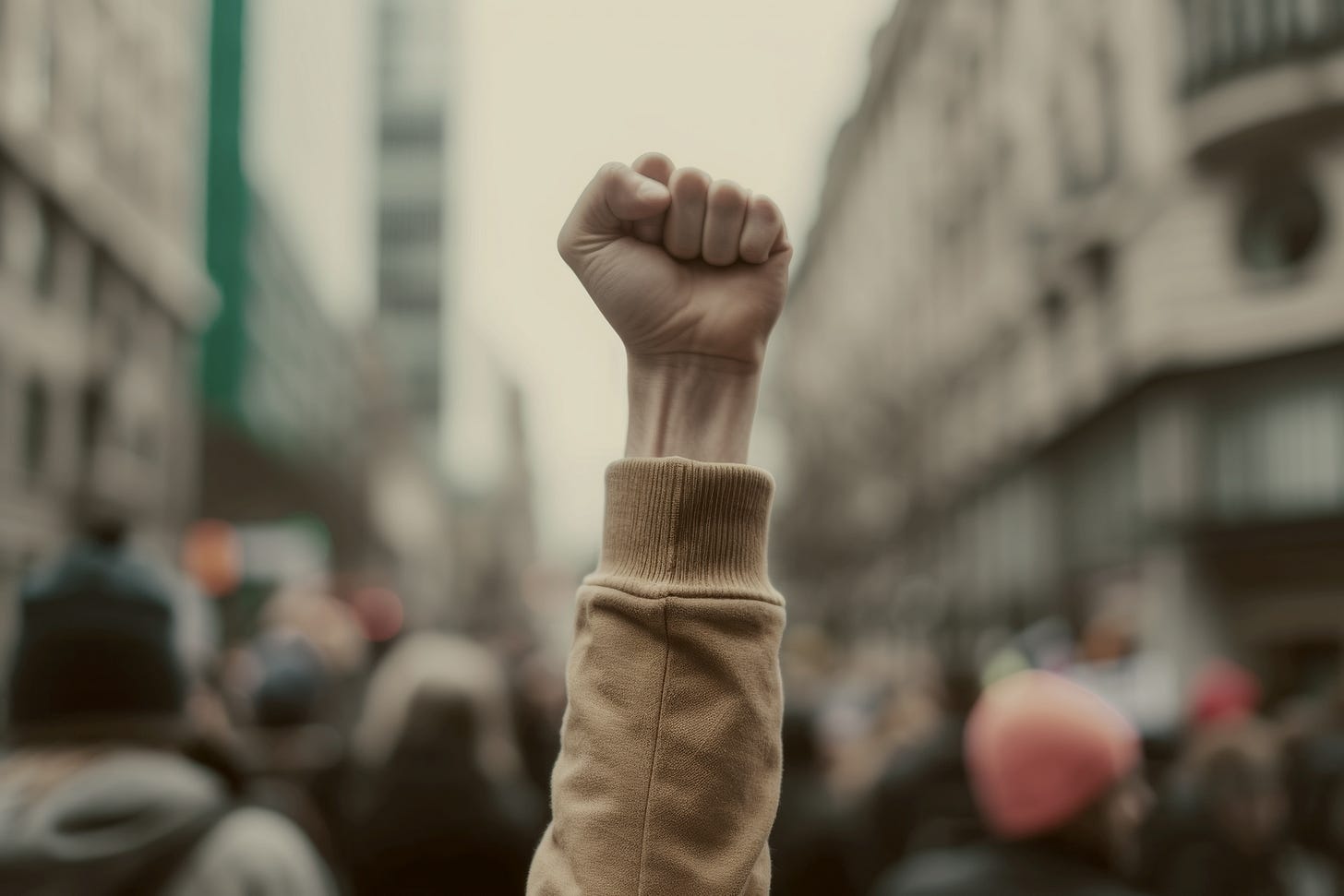NEW SERIES: How We Stave Off Burnout, When Democracy is Under Strain
A practical, research-informed guide to understanding how political stress drives burnout — and how to build the habits, mindset and support to protect your energy and keep resistance sustainable.
Dear friends
For fifty years, psychologists and occupational health specialists have argued about burnout. In 2019, the World Health Organization finally gave it formal recognition, defining burnout as a psychological syndrome that arises specifically from chronic workplace stress that has not been successfully managed. WHO does not classify burnout as a medical condition, but as an occupational phenomenon. But even though research and medicine generally define burnout as being work-related, I’ve come to understand it as something much broader.
I have experienced burnout, and it did not arise from work related stressors but from enduring a decade under authoritarian rule, against the background of a chronic medical condition and other personal stressors. In the run-up to the burnout, my work — although high pressure — provided me with welcome relief. That’s why I’d question the narrow way most studies frame burnout, treating it only as the outcome of stressful conditions at work. My lived experience suggests that burnout does not always originate in the workplace. It may become visible there, but its roots lie elsewhere.
That is now backed-up by research. A large review1 pooling results from forty-eight long-term studies found that workplace stressors have only a modest effect in predicting burnout. More striking was the reverse pattern: people already experiencing burnout were more likely to perceive and report stressful conditions at work. This is why, in this time of political upheaval — especially as authoritarianism is advancing — I believe we need to widen the lens.
Through my own experience I’ve come to understand burnout as what happens when the human body is asked to bear unrelieved stress with no real chance to recover. This is the ground on which I am building something for all of us: a toolkit to help ensure that, no matter what is happening in our personal lives or in the wider political environment, none of us burns out. In this new series, I’ll share that toolkit with you. But first — and as mentioned in my last post — we begin with psychoeducation.
It is human nature to keep pushing through the effects of stress until the moment comes when we simply cannot push any further. Only then do we recognise that something must change. In a workplace we can, at least in principle, step away from burnout triggers — we can change jobs, take leave, or set boundaries. Under authoritarian rule we do not have that option. This means that burnout becomes not just a risk but an almost inevitable outcome. And — crucially — if we wait to take action until we are experiencing it, we will have no way back to full recovery.
This is why psychoeducation is of critical importance. It gives us the grounding to understand not only what burnout is, but why we must act before we reach the point of collapse. When we grasp the mechanisms, the action steps that follow are no longer just another set of tasks in an already overloaded life. They become clear, necessary choices. And it is that understanding — the why behind the what — that makes us most likely to stay with them. Sticking with them is the only path to avert what will be, to many of us, inevitable.
For clarity: there is no established body of research on burnout under authoritarian rule. That makes sense when we think about how authoritarian systems restrict independent inquiry — research that might expose the effects of repression on populations is unlikely to be permitted to take root. But if we wait for that research to appear before we act, we risk becoming the very case studies on which it is one day built.
I have five things to offer you here that few others do: personal experience of both burnout and authoritarianism, a background in psychology, a love of wading through research papers, and additional qualifications in mitigating stress (more on that below). In the weeks and months ahead, I’ll be putting these skills and interests to full use in my best attempt to trace the evidence we do have, the patterns it points to, and to build the toolkit that will help us move through this time with care and clarity.
October marks the start of our “Resilient Resistance” publication with this new series of posts: “How we stave off burnout when democracy is under threat”. This series is designed to do two things: to make clear how burnout is being engineered around us, and ultimately, to give us the tools to resist it before it takes hold.
Starting next week and continuing through October, I’ll be publishing two posts a week — on Tuesdays and Fridays — which will follow this path:
What burnout does to resistance. We’ll start by exploring why staving-off burnout is key — how it drains not just individuals but movements, and why authoritarian systems exploit this dynamic so effectively.
Prolonged stress — the root of burnout. We’ll move to looking at the difference between acute stress and chronic stress in a political context, and understanding how chronic stress quietly reshapes how we think, feel, and act. (Premium subscribers will be able to download a checklist to help spot where it might already be showing up.)
What democratic erosion does to us physically. Authoritarian drift doesn’t just affect institutions — it affects every cell in our bodies. We’ll uncover the physical impact of living under constant strain, and how this raises the risk of longer-term health problems. (Another checklist will help premium subscribers connect the dots in your own experience.)
From chronic stress to burnout. We’ll trace how chronic stress develops into burnout, and set out the three signs that define it.
Burnout patterns and political engagement. We’ll look at how the recognised burnout patterns map onto our political engagement — and how to recognise when engagement itself can tip into depletion.
Who is most at risk. We’re not all equally vulnerable to burnout — research shows that some of us face higher risk than others. This post will lay out who is most at risk, so we know to put support in place early. (The full post is for premium subscribers, with a substantial preview for all.)
How we were primed. Even before the presidential election, the level of political stress in the United States had already primed We The People for burnout. I’ll walk through how that happened and why it matters. (For premium subscribers only.)
Trump’s burnout playbook. I’ll close the month by setting out how Trump is following the ultimate strategy for producing burnout, and how it will serve to cement authoritarian control in America.
Next month we will begin to move into solution-mode.
Before we get there, it may help if I share a little more about my own training and experience. My background is in psychological wellbeing, and I’m trained in a number of complementary fields — each one focused on relieving chronic stress.
Although I don’t practice, I’m a qualified herbalist, naturopath, and shinrin-yoku (forest bathing) teacher. I have practiced meditation and breathwork for over thirty years, and I am qualified to teach both yoga and qi gong. I’ve trained in both Mindfulness Based Stress Reduction (MBSR) and Mindfulness Based Cognitive Therapy (MBCT). And I was formerly a Fellow of the Complementary Medicine Association, as well as a member of the British Association of Lifestyle Medicine.
Lifestyle medicine looks at how our lifestyle shapes our health over time. It is built on six key pillars — nutrition, movement, sleep, social connection, avoidance of unhealthy substances, and stress management. It focuses on preventing illness and supporting long-term wellbeing. I’ve come to think of it as a wheel, with stress management at the hub, and the other pillars as the spokes leading out from it. The relationship is bidirectional, so each of these areas affects the others — and when we are under chronic stress, the whole wheel can buckle. But equally, the other spokes can help mitigate that stress. That’s why any toolkit for resilience needs to bring them all into play. Over the months ahead, I’ll also draw on this training to show you how.
I share this so you know that what I’ll be writing here rests on solid ground — both from my own experience and from years of training.
From November, these threads will begin to come together in this space. For now, our focus is on psychoeducation — understanding how chronic stress can lead to burnout, how authoritarian regimes build this in, and why that’s exactly where they want us.
I write here, and in my sister publication Presidential Power Watch, as a public service. My life experiences and training have provided me with unique preparation for this moment, and I feel a responsibility to use them to help us navigate it together. This is the work I am committed to — building clarity, resilience, and practical tools for staying effective under pressure, in a time when they are urgently needed.
Every subscriber plays a part in sustaining this work. Free and paid subscribers alike can help by liking, commenting, and sharing posts. Each of those small actions helps the algorithm place this work in front of others who may need it. Paid subscriptions add another layer of support: they make it possible for me to do this work full time, and they ensure that much of what I write can remain freely available to all.
For the next seven days, I’m offering a third off the subscription price — locked in for life. If you would like to be sure of receiving every post and every resource in the month ahead, and at the same time help sustain this work for the wider community, I warmly invite you to become a premium subscriber.
And whether you choose free or premium, I’m grateful you’re here. Your presence and engagement are what make this work matter.
In solidarity, as ever
— Lori
P.S. If you feel you can’t wait, and need tools to steady yourself now, I’ve already put together some posts with foundational practices for managing your stress response. Think of them as a starting kit you can turn to straight away, while this new series builds out the wider context.
This is part one of a series of six. For some reason I can’t embed the other posts, but scroll through all my posts and you’ll find each one — they’re freely available to all readers.
If you feel like there’s too much coming at you, and you don’t have the resources to meet it, this will help you in the moment.
And if you need help telling the difference between fear-driven catastrophising and clear-eyed assessment, the link below offers helpful practices:
How to Stop Catastrophising When the Worst-Case Feels Inevitable
(Sorry — I’m having an issue formatting embeds!)
Guthier, C., Dormann, C., & Voelkle, M. C. (2020). Reciprocal effects between job stressors and burnout: A continuous time meta-analysis of longitudinal studies. Psychological Bulletin, 146(12), 1146–1173. https://doi.org/10.1037/bul0000304






This is so helpful! Thank you.
Oh lordy, do we need this - and you!! Thank you!!